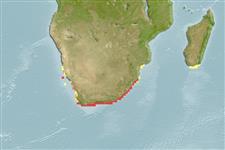>
Mugiliformes (Mullets) >
Mugilidae (Mullets)
Etymology: Pseudomyxus: Name from the genus Myxus preceeded by Greek prefix 'pseudo' meaning 'false'..
More on author: Valenciennes.
Environment: milieu / climate zone / depth range / distribution range
Ecologie
marien; zoet water; brak water demersaal; katadroom (Ref. 51243). Subtropical; 25°S - 35°S
Africa: endemic to South Africa, in east coastal estuaries and rivers from the Breë River to Kosi Bay (Ref. 7248, 52193).
Lengte bij maturiteit / Grootte / Gewicht / Leeftijd
Maturity: Lm 23.0 range ? - ? cm
Max length : 45.0 cm FL mannelijk / geslacht onbekend; (Ref. 52193)
Dorsale stekels (totaal): 5; Dorsale zachte stralen (totaal): 8; Anale stekels 3; Anale zachte stralen: 9.
Adults occur in freshwater to estuarine conditions. Adults breed at sea, throughout the year; juveniles move into estuaries and enter rivers usually in late winter or early spring (Ref. 52193). Females remain in freshwater for 7 years, males for 4 years (Ref. 52193). Return to estuaries before maturing sexually prior to spawning (Ref. 52193). Oviparous, eggs are pelagic and non-adhesive (Ref. 205). Feed on benthic algae and small invertebrates over muddy bottom (Ref. 6465). Decline in population from obstruction, by dams and weirs, of free passage into rivers.
Levenscyclus en paargedrag
Maturiteit | Voortplanting | Paaien | Eieren | Fecunditeit | Larven
Breed at the sea throughout the year. Juveniles move into estuaries and enter rivers usually in late winter or early spring. Males remain in freshwater until 4 years, females for up to 7 years. Fish return first to estuaries before maturing sexually prior to spawning (Ref. 7248).
Thomson, J.M., 1986. Mugilidae. p. 344-349. In J. Daget, J.-P. Gosse and D.F.E. Thys van den Audenaerde (eds.) Check-list of the freshwater fishes of Africa (CLOFFA). ISNB, Brussels, MRAC; Tervuren; and ORSTOM, Paris. Vol. 2. (Ref. 3573)
Status op de Rode Lijst van het IUCN (Ref. 130435)
Gevaar voor de mens
Harmless
Gebruik door de mens
Visserij: commercieel; Aquarium: Commercieel
Meer informatie
ReferentiesAquacultuurAquacultuurprofielKweeklijnenGeneticaElectrophoresesErfelijkheidZiektesVerwerkingNutrientsMassaconversie
Tools
Speciale rapporten
Download XML
Internetbronnen
Estimates based on models
Preferred temperature (Ref.
123201): 15.3 - 24.9, mean 22.6 °C (based on 20 cells).
Fylogenetische diversiteitsindex (Ref.
82804): PD
50 = 1.0000 [Uniqueness, from 0.5 = low to 2.0 = high].
Bayesian length-weight: a=0.01175 (0.00668 - 0.02065), b=2.96 (2.81 - 3.11), in cm total length, based on LWR estimates for this species & (Sub)family-body (Ref.
93245).
Trofisch niveau (Ref.
69278): 2.8 ±0.27 se; based on food items.
Weerstandsvermogen (Ref.
120179): Gemiddeld, minimale populatieverdubbelingstijd 1,4-4,4 jaar (Preliminary K or Fecundity.).
Fishing Vulnerability (Ref.
59153): Moderate vulnerability (40 of 100).
